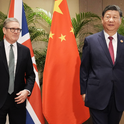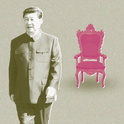Read the rest of Prospect's big ideas of 2016 here
All over the world, borders are being remade to take account of new political realities. In the Middle East, an Islamic State (IS) propaganda video from 2014 shows the terrorist group blowing up an old border post between Iraq and Syria—a relic of the 1916 Sykes-Picot Agreement, much disliked in the Arab world for creating colonial boundaries. Pan-Arabists have long dreamed of a United Arab Republic, though attempts to create one have always ended in failure. As both Iraq and Syria are carved up on factional lines, it will make less sense to speak of them as unified countries. And while few Arabs will mourn the end of Sykes-Picot, the decline of the idea of the Arab nation state with protected religious and ethnic minorities will arguably only store up more trouble for the future.
In 2014, Russia annexed Crimea in order, it argued, to defend Russian speakers who lived there from pro-European Ukrainians (see Annabelle Chapman, p58). As Andrew Stuttaford argued in Prospect in August, President Vladimir Putin might also have in his sights a trio of Baltic states—Estonia, Latvia and Lithuania—which have asked for Nato assistance in defending their borders. Putin wants to push back the boundaries created when the Soviet Union fell in 1991 as part of his wider project of expanding Russian influence into the east. How far Europe will let him go remains to be seen.
In South America, Venezuela and Colombia have been arguing over their porous borders. In August, President Nicolas Maduro of Venezuela closed the border crossings connecting Táchira state and Colombia’s Norte de Santander department. He wanted to stop subsidised goods such as toilet paper, cooking oil and corn flour which were being smuggled into Colombia and sold at high prices. Around 1,500 Colombians living illegally in Venezuela were evicted as part of Maduro’s anti-smuggling operation. Colombia’s President Juan Manuel Santos responded by saying that cooperation rather than unilateral action was the way forward, and in September the two sides agreed to a “a progressive normalisation” of their border.
In Europe, 30 years after the Schengen Agreement was signed guaranteeing freedom of movement, borders are going back up. In Hungary, razor-wire fences are being erected to stem the flow of refugees. After the Paris attacks of 13th November, France reintroduced temporary border controls to check up on who was entering its territory and turned away 1,000 people trying to get in. Yet according to a recent poll, 57 per cent of Europeans still think the that free movement of people, goods and services within the EU is one of the “most positive results” of increased union. Balancing the convenience of its citizens with the problems caused by the refugee crisis and the terrorist threat will be one of the EU’s biggest challenges in 2016.
All over the world, borders are being remade to take account of new political realities. In the Middle East, an Islamic State (IS) propaganda video from 2014 shows the terrorist group blowing up an old border post between Iraq and Syria—a relic of the 1916 Sykes-Picot Agreement, much disliked in the Arab world for creating colonial boundaries. Pan-Arabists have long dreamed of a United Arab Republic, though attempts to create one have always ended in failure. As both Iraq and Syria are carved up on factional lines, it will make less sense to speak of them as unified countries. And while few Arabs will mourn the end of Sykes-Picot, the decline of the idea of the Arab nation state with protected religious and ethnic minorities will arguably only store up more trouble for the future.
In 2014, Russia annexed Crimea in order, it argued, to defend Russian speakers who lived there from pro-European Ukrainians (see Annabelle Chapman, p58). As Andrew Stuttaford argued in Prospect in August, President Vladimir Putin might also have in his sights a trio of Baltic states—Estonia, Latvia and Lithuania—which have asked for Nato assistance in defending their borders. Putin wants to push back the boundaries created when the Soviet Union fell in 1991 as part of his wider project of expanding Russian influence into the east. How far Europe will let him go remains to be seen.
In South America, Venezuela and Colombia have been arguing over their porous borders. In August, President Nicolas Maduro of Venezuela closed the border crossings connecting Táchira state and Colombia’s Norte de Santander department. He wanted to stop subsidised goods such as toilet paper, cooking oil and corn flour which were being smuggled into Colombia and sold at high prices. Around 1,500 Colombians living illegally in Venezuela were evicted as part of Maduro’s anti-smuggling operation. Colombia’s President Juan Manuel Santos responded by saying that cooperation rather than unilateral action was the way forward, and in September the two sides agreed to a “a progressive normalisation” of their border.
In Europe, 30 years after the Schengen Agreement was signed guaranteeing freedom of movement, borders are going back up. In Hungary, razor-wire fences are being erected to stem the flow of refugees. After the Paris attacks of 13th November, France reintroduced temporary border controls to check up on who was entering its territory and turned away 1,000 people trying to get in. Yet according to a recent poll, 57 per cent of Europeans still think the that free movement of people, goods and services within the EU is one of the “most positive results” of increased union. Balancing the convenience of its citizens with the problems caused by the refugee crisis and the terrorist threat will be one of the EU’s biggest challenges in 2016.













